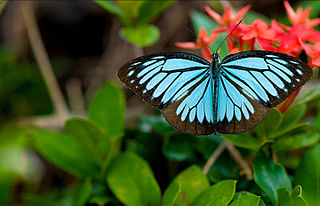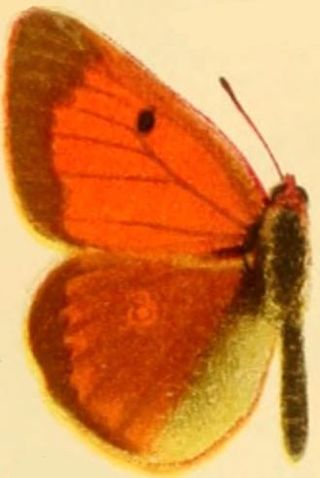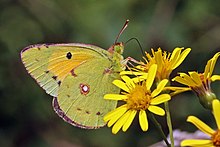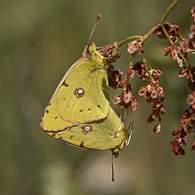
The green hairstreak is a small butterfly in the family Lycaenidae.

Colias hyale, the pale clouded yellow, is a butterfly of the family Pieridae, which is found in most of Europe and large parts of the Palearctic. It is a rare migrant to the British Isles and Scandinavia. The adult wingspan is 52–62 millimetres (2.0–2.4 in).

Colias alfacariensis, Berger's clouded yellow, is a butterfly of the family Pieridae. It was separated from the pale clouded yellow, C. hyale, in 1905. Berger's clouded yellow is a Palearctic species (South and Central Europe, South Russia, Russian Far East, Siberia Central Asia and temperate China also Asia Minor, Caucasus and Transcaucasia.

The short-tailed blue or tailed Cupid is a butterfly that forms part of the family Lycaenidae. It is found from Europe to Japan and in India.

Pareronia valeria, the common wanderer or Malayan wanderer, is a medium-sized butterfly of the family Pieridae, that is, the yellows and whites, and is found in India and Southeast Asia. The butterfly found in India is sometimes considered as a separate species, Pareronia hippia.

The Nilgiri clouded yellow, Colias nilagiriensis, sometimes considered a subspecies of Colias erate, is a small butterfly native to Shola forests of the Western Ghats. It belongs to the family Pieridae.

Colias chrysotheme, the lesser clouded yellow, is a small Palearctic butterfly belonging to the family Pieridae.

Colias is a genus of butterflies in the family Pieridae. They are often called clouded yellows in the Palearctic and sulphurs in North America. The closest living relative is the genus Zerene, which is sometimes included in Colias.

Colias palaeno, known by the common names moorland clouded yellow, palaeno sulphur, and pale Arctic clouded yellow, is a butterfly in the family Pieridae.

Colias philodice, the common sulphur or clouded sulphur, is a North American butterfly in the family Pieridae, subfamily Coliadinae.

Plebejus argyrognomon, common name Reverdin's blue is a butterfly of the family Lycaenidae. The species is named after Jacques-Louis Reverdin.

Colias phicomone, the mountain clouded yellow, is a butterfly in the family Pieridae. It is found in the Cantabrian Mountains, the Pyrenees, the Carpathian Mountains and the Alps. It flies at altitudes of 900 to 2800 meters.

Cupido alcetas, the Provençal short-tailed blue, is a small butterfly that belongs to the family Lycaenidae.

Colias myrmidone, the Danube clouded yellow, is a butterfly in the family Pieridae.

Colias erate, commonly known as the eastern pale clouded yellow, is a species of butterfly in the family Pieridae. It is found from south-eastern Europe, through Turkey over central Asia up to Japan and Taiwan. To the south, its range stretches to Somalia and Ethiopia. The species was first described by Eugenius Johann Christoph Esper in 1805.

Kricogonia lyside, the lyside sulphur or guayacan sulphur, is a North American, Caribbean, and South American butterfly in the family Pieridae.

Colias marcopolo, the Marco Polo's colias, is a butterfly in the family Pieridae found in the Pamir Mountains the Hindu Kush and Afghanistan.

Colias heos is a butterfly in the family Pieridae. It is found in the East Palearctic.
























